
PUMPA - SMART LEARNING
எங்கள் ஆசிரியர்களுடன் 1-ஆன்-1 ஆலோசனை நேரத்தைப் பெறுங்கள். டாப்பர் ஆவதற்கு நாங்கள் பயிற்சி அளிப்போம்
Book Free DemoEducation is considered to be mandatory and is treated as a pre-requisite for majority of the professions available in today's modern society. But when one goes back and traces the history and progress of education and the institutions that provided it to people, one can learn that we have come a long way. India is a country of rich and varied resources in terms of religion, culture and education. Until the British advancements that were made during the \(1850s\), India preserved manuscripts and resources that contained huge philosophies and learnings of great men. After India was colonised, Education system started to change its approach and methods of inducing knowledge. Numerous learned men, scholars and philosophers travelled from all over the world to India in the pursuit of knowledge. India blended education with its rich heritage and culture. They found India to be a land of wonder.
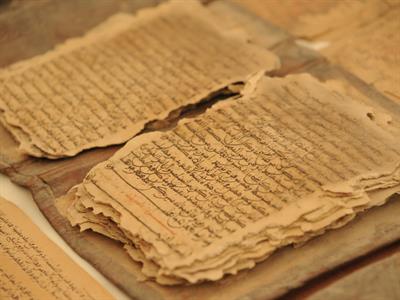
Manuscripts*
The world is a diverse place with different people who live across the globe, who adhere to different cultural practices, languages, faiths, climatic conditions etc. Amongst all these varied existences, people found India's approach to education, its manuscripts, scriptures to be rich. The fame of Indian culture, wealth, religions, philosophies, art, architecture, as well as its educational practices, had spread far and wide. The Indian education system was believed to have promoted humanity and a positive approach to life. Ancient Indian Education has been evolved strictly on the foundations of Indian philosophical traditions and scriptures. The ultimate aim of education emerged as the Chitti-Vritti-nirodha (the control of mental activities connected with the so called concrete world). The student would not remain contended with mere bookish learning but acquire fairly practical knowledge of the world and society through close contact with the people.
Some famous explorers who visited India are Ibn Batuta, the Moroccan scholar who wrote the famous book 'The Riḥlah' (Travels). Chinese scholars such as Xuanzang and Yi Jing arrived in Indian institutions of learning to survey Buddhist texts. Apart from scholars, India was also visited by architectural students as it was a country famous for its art and architecture. The Ajanta and Ellora caves, The Tanjore temple, Charminar, the Mamallapuram forts were all studied extensively by students and researchers from all around the globe.
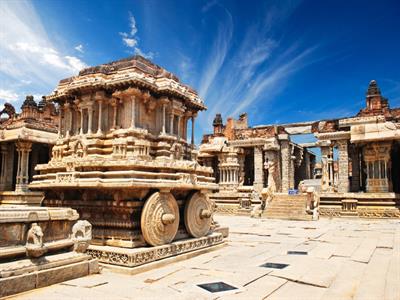
Indian architecture from Hampi temple
The Ancient education system in India had a definite ideal and mission. Unlike the western education system, it did not just focus on inculcating the students with subject related knowledge. Teaching and learning followed the tenets of Vedas and Upanishads fulfilling duties towards self, family and society, thus encompassing all aspects of life. The basis of Indian culture lies in the Vedas, which are four in number- Rigveda, Samaveda, Yajurveda and Atharvaveda. The Vedas are regarded as the oldest among the literatures of the world and is regarded as the original sources of the philosophy of life in ancient India.

The Four Vedas**
The Rig Veda is based on “Knowledge of the Hymns of Praise” for recitation. From the times of Rig Veda, which focussed on hymns and recitations, education slowly evolved into inculcating both the inner and outer self of an individual and establishing a holistic development. Holistic development focuses on the individual as a whole and not as parts or one particular aspect. Therefore education proved to focus on the moral, physical, spiritual and intellectual aspects of life. Rather than teaching facts and defined statements, students were taught values such as humility, truthfulness, discipline, self-reliance and respect for all creations. Indians always tried to establish a lifestyle that was one with nature. They viewed nature as a source of life. Even the Gods they worshipped were in relation with the elements of nature such as Sun, water, earth etc. They learnt to draw their sustenance from nature, in turn protecting the ecosystem that they lived in.

Blending nature with learning
Education blended harmony with nature and knowledge. They learnt to appreciate the balance between human beings and nature. Education was not just restricted to learning and sharpening one's brain but also dealt with physical activities such as archery, athletics etc. The Vedas and Upanishads were not only religious and cultural texts. They taught various life lessons and made one understand how to focus on the self, family and the other inhabitants of the world. Education focussed on achieving a sound mind in a sound body. Indian education taught one how to deal with life or the problems it offers in a practical way, rather than giving an idealistic approach. It was achievable and offered to the students' insight, in the areas that they were lacking, thus being complementary.
Education in India included all areas that an individual needs to live a healthy and happy life. It was not theoretical, rather students acquired knowledge in a practical way, gaining hands-on experience with the subjects. Education was divided into various specific areas, each making the student one step closer to achieve holistic development. Since there was no impact of colonisation, Christian missionaries and their convent style of education had not prevailed until the 18th century. Education still held on to the approaches led by the Vedas, Brahmanas, Upanishads and Dharmasutras. The Vedas codified the ideas and practices of Vedic religion and laid down the basis of classical Hinduism. They were probably composed between \(1500\) and \(700\) BC and contain hymns, philosophy, and guidance on ritual. The Brahmanas were scriptures that contained the lengthy commentaries of the Vedas. The Upanishads and Dharmasutras were also sacred religious texts that lay various conflicting points of views of life.
Apart from the scriptures, treatises of various learned scholars also provided as the base for education. Aryabhata was the greatest mathematician and astronomer of the classical age. His famous work 'Aryabhatiya' is still considered as one of the best references for plane trigonometry and algebra by students of mathematics. When it comes to Sanskrit, Panini is considered to be the best scholar to be referred. His text 'Aṣṭādhyāyī' a sutra-style treatise on Sanskrit grammar, \(3959\) verses or rules on linguistics, proved to be a seminal text for early education. Katyayana was also a grammarian and scholar whose texts were referred in the early times. Patanjali is still regarded as the best scholar for his works on yoga and medicine. When it came to medicine, Charaka who was a physician and Sushrutha, a surgeon, contributed greatly with their writings and research, especially in terms of Ayurveda medicine. These were the major sources and references for early education.
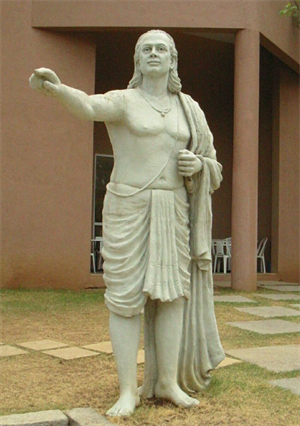
A statue for Aryabhata in Pune***

Ayurvedic form of medicine
In today's modern higher education system, streams are classified into arts and science. Similarly, the ancient education system too had distinctions between the subjects and areas that have to be learnt in a formal way and areas that required imaginative and creative skills. For example, one has to learn formulas and equations for subjects like maths or science. One cannot twist or turn facts. Whereas in subjects in literature, there is no right or wrong. One person's interpretation of a poem can be completely different from the other person and both can still be right. The learned disciplines such as science were called the Shastras and the imaginative and creative arts were called Kavyas. Within these streams, references were taken from various sources.
Disciplines taken into consideration were mostly 'Itihas', the history which comprises mostly of facts and references to the past. Students had to know their past to develop their future. Anviksiki (Logic), which blended reasoning with logic, Mimamsa (Interpretation) which belonged to the creative spaces and provides philosophical justification to the Vedas, Shilpashastra (Architecture) which taught learners all about the designing of buildings and domes, Varta (agriculture, trade, commerce, animal husbandry) which dealt with specific skills and Dhanurvidya (archery) which focussed on strengthening physical skills. All these disciplines together contributed to holistic learning.
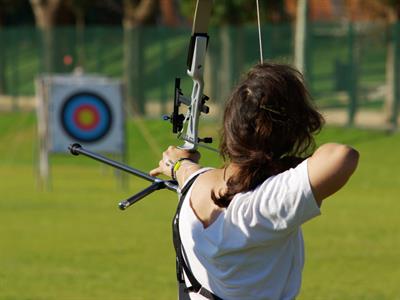
Archery
Physical education was given equal importance as learning skills and facts. It was again diversified into krida (games, recreational activities), where the students focused on games that kindled their mind as well as body, such as kabaddi, kho-kho etc, vyayamaprakara (exercises) which involved the students flexing their body to stay fit, Dhanurvidya (archery) as it was essential in those days as a part of self-defence, and yogasadhana (training the mind and body) where students would perform asanas such as suryanamaskar to cleanse themselves. The pupils would stay in gurukuls and work with their gurus (teachers) to achieve these skills. They also had collaborative learning and peer work where they would have healthy debates over various topics (shastrartha) where they would also be guided by their senior pupils.

Yoga
Today, in this world of technological advancements, many people are opting for home schooling. This way, parents can have good control over the child's learning and there is flexibility in timings. There are also parents who put their children in good boarding schools, as they are not able to be present with them. Similarly, the ancient education system had both formal and informal ways of acquiring education. There are certain things that cannot be taught and only be imbibed. Children acquired knowledge on pious and religious ways of life from elders who were within the family or society. Students learnt many art forms or skills in an informal way from mere observation and listening to experienced people's wise words. Most of this learning happened in temples as it was a routine for people to visit the temples when there was an auspicious day. Indigenous education was imparted at home, in temples, pathshalas, tols, chatuspadis and gurukuls.
Viharas and universities were established throughout the country. The Viharas were Buddhist monasteries that were initially built for monks to meditate. It later became the centre for learning. The teachings were highly oral as there were only less facilities. Paper was still a rare commodity in the early days and the students internalised the lectures given. Schooling in the ancient days was given in the gurukuls. The guru (teacher) would most often be a sage. The Gurukul is a type of school in the ancient education system. Their main motto is to develop knowledge and they are highly focused on education. The Gurus train their students with meditations, yoga and other standards.
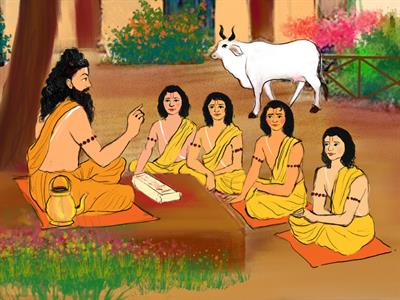
Gurukul education****
The teacher is called a Guru and the students are called Shisyas. They were situated in a serene environment such as a forest. Students consider the gurukul as a second home as they stayed there for many years. The education imparted in gurukuls is not just restricted to men. Women like Maitreyi, Viswambhara, Apala, Gargi and Lopamudra went on to become famous Vedic scholars. Education consisted of learning about basic skills such as wood gathering, cooking along with the Vedas. They learnt subjects like arts, history, law on a practical basis and not just with respect to definitions.
In the early days, when Buddhism was emerging as a predominant religion, many monasteries or Viharas were set up for the Buddhist monks to meditate and enter into a conversation with the supreme being. They would use the space to debate on the universal truths, establish a holy communion. They had a quest for knowledge and used this forum to gain divinity. Slowly it emerged as a space for education as well. The places around the Viharas evolved into learning centres, where students from China, Korea, Tibet, Burma, Ceylon, Java, Nepal and other distant countries would visit to gain knowledge on all subjects. These were countries that were closer to India, and as a result of these visits, Buddhism got propagated into these lands. Even today, these countries prove to be Nations where Buddhism is a predominant religion.
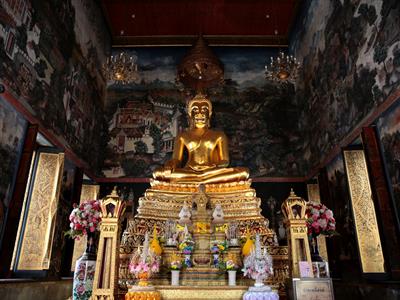
A Vihara in Bangkok*****
In order to establish an education centre, one has to observe the locality and the areas that tend to attract them. The Jataka tales are a voluminous body of literature native to India concerning the previous births of Gautama Buddha in both human and animal form. They have a huge account of the Viharas and the system that they followed. This can serve as a basis or source for knowing more about the education system during those days. Apart from these, Xuan Zang and I-Qing, two scholars from China who brought Buddhism to their country, also have provided sources to show that kings and society took an active interest in promoting education. A lot of universities were established around the towns to promote learning and the quest for knowledge in students.
Takshashila, Nalanda, Valabhi, Vikramshila, Odantapuri and Jagaddala were some of the Universities that were established around the Viharas and therefore had traces of Buddhist teachings and doctrines. Those at Benaras, Navadeep and Kanchideveloped in connection with temples and became centres of community life in the places where they were situated, as these were holy places of the Hindus. Pilgrims visited these places every year. Universities, in general, were centres for higher learning and had various resources and scholars, which the students could make use of. Apart from this, the King of the place would summon scholars and students from these Universities and conduct a meeting where they could debate over various topics and learn from them.
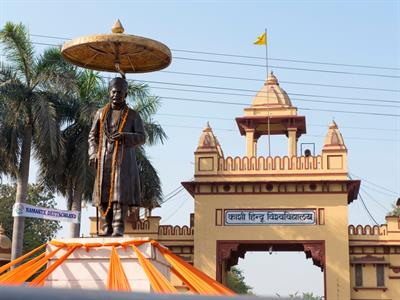
Hindu University in Benaras******
The University of Taxila was established on the eastern banks of the Indus river. Although it belonged to India during pre-Independence, it is now located in Taxila, Pakistan. It is the seat for Buddhist philosophy and doctrines. The Jataka tales had references to this University in some of its stories, as it was solely based on Buddhist doctrines. But the earliest mention of the University was in Valmiki's Ramayana, as it is believed that the city of Taxila was established by Bharata, the brother of Lord Ram. It can be traced back to the early \(800)\ BCE. Taxila or Taksha is short for Takshashila. It is named after the Taksha's rock-cut in Ancient Northern India. Takshashila means 'City of cut stone'. It was designed as the Wealthiest place of that time, as it was rich in resources.
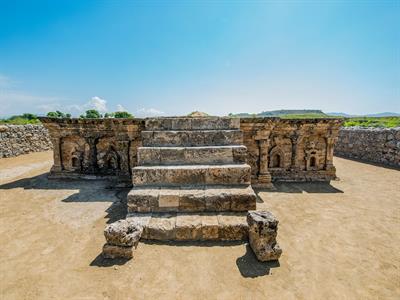
Taxila University
Scholars from all over the World, especially Kashi, Kosala, Magadha, attended the University to learn various art forms and religious scriptures. They also learnt science, law, medicine etc. The curriculum consisted of 68 elective courses, including philosophy, law, statecraft, defence, warfare strategies, grammar (several languages), the 18 arts (music, dance, fine arts, etc.), mathematics, astronomy, astrology, plants & herbs, medicine (Ayurveda, Ayurvedic acupuncture, etc.), and surgery. Some of these, such as medicine, were taught for up to seven years before graduation. It was also known for 18 shilpas or rock cuts which were studied and researched exclusively. Taxila was destructed by the Huns in the early 5th century CE.
It is an important archaeological site and the UNESCO declared it to be a World Heritage Site in \(1980\). A lot of Taxila's pupils went on to become famous in their fields. Panini, a legendary Indian grammarian, was an expert in language and grammar and authored one of the greatest works on grammar called Ashtadhyayi. Jivaka, one of the most renowned physicians in ancient India, and Chanakya (also known as Kautilya), a skilled exponent of statecraft, both studied here. Teachers had complete freedom to choose their students, design curriculum based on individual preferences and decide on when the course would end. Senior students assisted the teachers and learning took place with the help of discussions and debates.
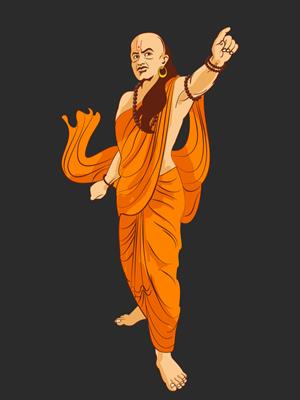
An illustrated picture of Chanakya
Located in present day Rajgir, Bihar, India, Nalanda was one of the oldest universities of the world and UNESCO declared the ruins of Nalanda Mahavihara a world heritage site. It functioned between the \(5th\) and \(13th\) century. Xuan Zang was a famous Chinese Buddhist monk who visited India during the seventh century. He visited with the purpose of tracing Chinese Buddhism with Indian Buddhism. He visited various Buddhist monasteries and sites. When he visited Nalanda, it was called Nala and was a centre of higher learning in various subjects.
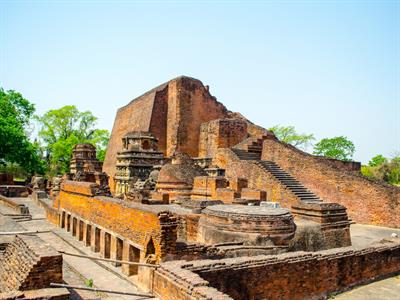
Ruins of Nalanda University
Xuan Zang visited Nalanda along with I-Qing, another fellow Buddhist monk and translator. It is through their writings and reports that we get to know how the University flourished during the early days. They have recorded that nearly a hundred lectures and discourses were given in the University on various subjects and fields. Like Taxila, Nalanda used debates and discussions as the mode of teaching. Xuan Zang studied Yoga in Nalanda, under Shilabadhra, the chancellor of the University. The students trained themselves in various areas like astronomy, Vedas, Medicine etc.
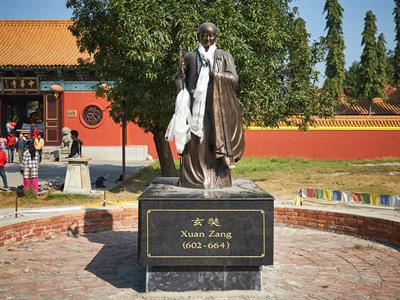
A statue of Xuan Zang*******
One important factor of education in Ancient days is that it was offered for free. Sponsors in the form of rich merchants and wealthy parents came in the form of lands and buildings. The only thing that was expected in return from the students was any form of contribution to the society, as in achieving in a particular field, researching or inventing on a new topic etc. Valabhi, Vikramshila and Jagaddala were also Universities that provided free education. When Nalanda and Taxila contributed to education in the north, The south of India had Agraharams, which is a Brahmin place of dwelling, where gurus taught the students Vedas and other subjects. It was also funded by donations from society. While Agraharams provided a large space of study, Ghatika and Brahmapuri, a centre of learning including religion and small in size, also provided a space to explore education.
Like all things that evolve under socio-political circumstances, Education in India too evolved. From Gurukuls, it progressed to ashrams in temples and as local schools established in different parts of the town. While all these had a touch of the Hindu principles and doctrines, the Mughal influence in India established Makthabas or Madrasas, where subjects like poetry, math, history were taught with respect to Islamic traditions. Around this time, indigenous education flourished in India, which was basically a system where one taught models, methods that were aligned to a particular culture and encouraged local-level decision making.
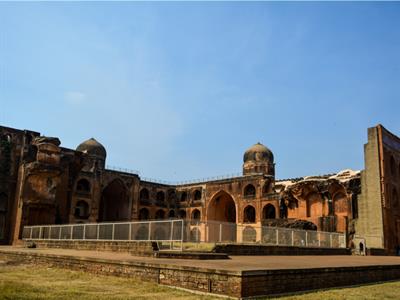
A Madrasa in Karnataka
In different parts of India, formal education was given with reference to their own local needs and spaces that were available. The South had Agraharams, Bengal had Tols, Chatuspadis in Bihar where different forms of schools that focussed on different areas. This system was mostly a religious and spiritual form of education. The society as a collective came forward to educate each other. While the rich contributed and sponsored for the education of young candidates, even villagers gave a small contribution in South India, as referred to in Books and Memoirs written by researchers.
The Ancient Education system focussed not only on external growth but also internal. In today's society, one may have degrees attached to their names but may have less knowledge on how one is to conduct himself or the impact of the degree with which he can serve the society. But Early education system was free and prepared the students to face life. It focused on the whole, as it aimed at holistic development. Our present day education can take inspiration from the ancient ways of learning from the outside world and not just books. Educationists are stressing on the importance of varied cultural beliefs being inculcated into education, thereby making it holistic.
Reference:
- Manuscripts*: Teo Tarras / Shutterstock.com
- The Four Vedas**: Westock Productions / Shutterstock.com
- Aryabhata***: Public domain, via Wikimedia Commons
- Gurukul education****: Young Moves Media / Shutterstock.com
- Vihara in Bangkok*****: Pathompong Trisukon / Shutterstock.com
- Hindu University in Benaras******: Arun Sambhu Mishra / Shutterstock.com
- A statue of Xuan Zang*******: Vladimir Zhoga / Shutterstock.com